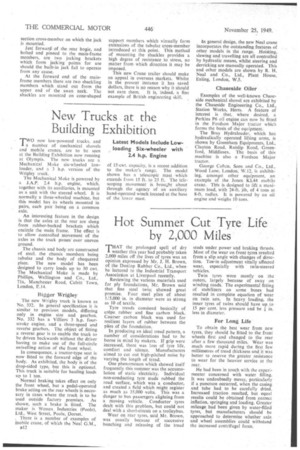Hot Summer Cut Tyre Life by 2,000 Miles
Page 38

If you've noticed an error in this article please click here to report it so we can fix it.
THAT the prolonged spell of dry weather this year had probably taken 2,000 miles off the lives of tyres was an opinion expressed by Mr. J. H. Brown, of the Dunlop Rubber Co., Ltd., when he lectured to the Industrial Transport Association at Liverpool recently.
Reviewing the various materials used for ply foundations, Mr. Brown said that fine steel twist showed great promise. Four steel plies of about 1/5,000 in. in diameter were as strong as 10 of textile.
Tyre treads consisted basically of crepe rubber and fine carbon black. Coarser carbon black was used for resilient layers of rubber between the plies of the foundation.
In producing an ideal tread pattern, a number of considerations had to be borne in mind by makers. If grip were increased, there was loss of tyre life, comfort and silence. Manufacturers aimed to cut out high-pitched noise by varying the length of tread.
One phenomenon which showed itself frequently this summer was the accumulation of static electricity. Individual non-conducting tyre studs rubbed the road surface, which was a conductor, and created a field which might register as much as 35,000 volts. This was a danger to bus passengers alighting from a moving vehicle. Conductor tyres dealt with this problem, but could not deal with a short-circuit on a trolleybus.
Wear on rear tyres, said Mr. Brown, was usually because of successive bunching and releasing of the tread studs under power and braking thrusts. Most of the wear on front tyres resulted from a slip angle with changes of direction. Toe-in adjustment vitally affected wear, especially with twin-steered vehicles.
Twin tyres wore mostly on the outers, largely because of sway on winding roads. The experimental fitting of stabilizers on some buses had resulted in complete equation of wear on twin sets. In heavy loading, the inner tyres of twins should have up to 15 per cent. less pressure and be in. less in diameter.
For Long Life
To obtain the best wear from new tyres, they should be fitted to the front wheels first and changed to the rear after a few thousand miles. Wear was much more rapid during the first few millimetres of tread thickness and it was better to reserve the greater resistance to wear for the heavier service at the rear.
He had been in touch with the experimenter concerned with water filling. It was undoubtedly messy, particularly if a puncture occurred, when the casing and tube had to be carefully dried. Increased traction resulted, but equal results could be obtained from correct inflation, springing and loading. Greater mileage had been given by water-filled tyres, but manufacturers should be approached to determine whether axle and wheel assemblies could withstand the increased centrifugal force.




















































































